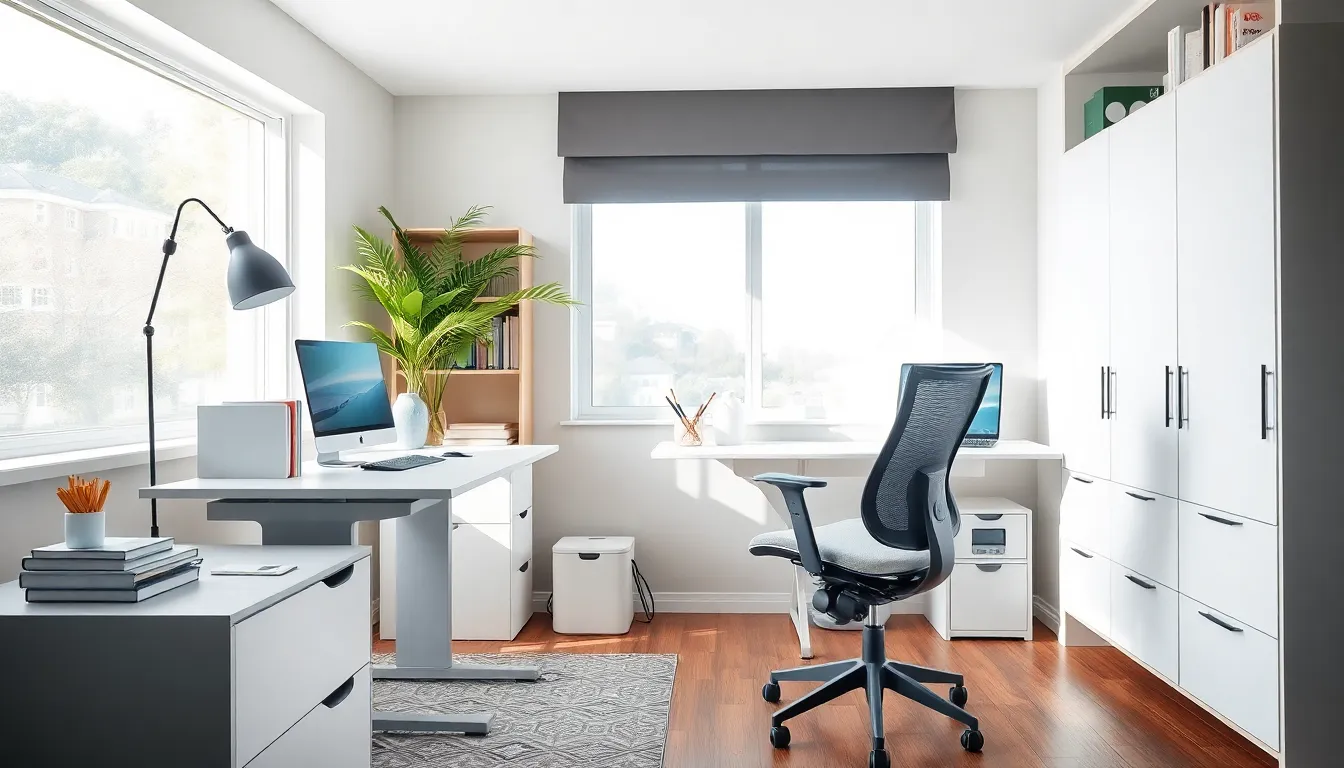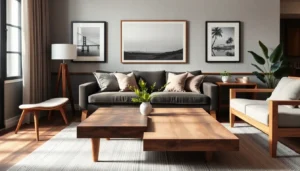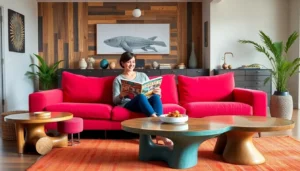Table of Contents
ToggleCreating the perfect study room is like assembling a superhero team. Each piece of furniture plays a vital role in battling distractions and boosting productivity. Whether it’s a desk that whispers sweet nothings of organization or a chair that cradles you like a supportive friend, the right study room furniture can transform any space into a haven of focus.
Imagine sinking into a comfy chair that feels like a cloud while your desk stands tall, ready to conquer the chaos of textbooks and papers. With the right setup, studying can feel less like a chore and more like an adventure. So, let’s dive into the world of study room furniture and discover how the right choices can turn your study space into the ultimate productivity powerhouse. After all, who wouldn’t want to study like a pro while feeling like a superhero?
Overview of Study Room Furniture
Study room furniture plays a significant role in creating an effective learning space. Key components include desks, chairs, shelves, and lighting, each contributing to a productive atmosphere.
Desks must provide adequate surface area for books, laptops, and stationery. A spacious desk enhances organization and minimizes clutter. Ergonomic designs support proper posture, reducing discomfort during long study sessions.
Chairs complement desks by offering comfort and support. Adjustable chairs help accommodate various body types. A quality chair encourages longer study durations by enhancing comfort and reducing fatigue.
Shelves and storage units organize materials efficiently. They keep textbooks, documents, and supplies within arm’s reach, streamlining study sessions. Open shelving promotes easy access, while closed cabinets can reduce visual distractions.
Lighting solutions significantly impact productivity. Natural light enhances mood and focus, while task lighting targets specific areas. Adjusting light intensity minimizes eye strain and promotes concentration.
Accessories like desk organizers, bulletin boards, and noise-canceling devices further enhance the study environment. Desk organizers maintain tidiness, while bulletin boards keep important reminders visible. Noise-canceling solutions minimize distractions, especially in shared spaces.
Selecting the right study room furniture ensures a tailored learning experience. Prioritizing comfort and functionality results in a nurturing environment that encourages focus and efficiency. Each element, when chosen wisely, contributes to an optimal study setting that supports academic success.
Key Features to Consider

Selecting furniture for a study room involves evaluating several key features that enhance comfort and functionality. Prioritizing ergonomics and material quality leads to an optimal learning environment.
Ergonomics
Comfort is critical during study sessions. Ergonomic furniture promotes proper posture, which helps reduce strain on the body. Chairs should have adjustable height settings, lumbar support, and cushioned seats to accommodate different body types. Desks with adjustable heights encourage more movement and flexibility. A comfortable workspace allows individuals to focus longer without discomfort, directly impacting productivity.
Material Quality
Durable materials contribute to a lasting study environment. High-quality wood, metal, or composite materials provide stability. Desks made from solid wood resist wear and tear, ensuring longevity. Additionally, upholstery on chairs should feature breathable fabric or quality leather for easy maintenance and comfort. Investing in well-constructed furniture results in fewer replacements and a more reliable study setup, ultimately supporting better learning outcomes.
Types of Study Room Furniture
Selecting the right study room furniture involves carefully choosing items that enhance productivity and comfort. Different types of furniture contribute uniquely to this goal.
Desks
Desks serve as the core of any study room. Ample surface area for materials like books and laptops supports effective study sessions. Many desks offer ergonomic designs that promote proper posture, reducing strain during long hours of work. Adjustable height desks cater to standing or sitting preferences, allowing for versatility. Styles range from minimalist to traditional, fitting various aesthetics and preferences. Choose a desk with built-in storage options for added functionality and organization.
Chairs
Chairs play a vital role in comfort during study times. An ideal chair provides both support and adjustability, accommodating different body types. Key features such as lumbar support and breathable materials enhance the overall experience. A chair with wheels can improve mobility, allowing easy movement around the study space. Focusing on static or dynamic seating options can cater to personal preferences and improve concentration. Finding a chair that encourages good posture will promote longer study sessions.
Storage Solutions
Storage solutions keep the study area organized and clutter-free. Bookshelves provide excellent space for textbooks, reference materials, and decorative items, creating a personalized study corner. Storage units with drawers can house supplies like pens, notebooks, and tech accessories, making them easily accessible. Choosing modular storage options allows for customization to fit the room’s layout. Consider open shelving for visibility or closed cabinets for a clean look. Well-organized storage aids in reducing distractions, creating an efficient study environment.
Aesthetic Considerations
Aesthetic elements significantly impact the study room’s overall feel and functionality. Selecting the right furniture can enhance both comfort and productivity.
Color Schemes
Color schemes play a vital role in shaping the study atmosphere. Neutral tones like beige or gray create a calming environment, suitable for focused work. Splashes of color, such as blue or green, can stimulate creativity and reduce stress. Consider using accent colors through accessories like cushions or desk organizers. Darker hues might absorb light, making the space feel smaller, while lighter shades can open up the area visually. Opting for a cohesive color palette ensures harmony and enhances visual appeal.
Style Coordination
Style coordination across furniture pieces adds a cohesive look to the study room. Furniture should complement each other in design and aesthetic to create a unified space. A modern desk pairs well with a sleek chair, enhancing the contemporary feel. Traditional furniture might benefit from ornate shelving units that match in style. Incorporating different textures, such as wood, metal, and fabric, can create visual interest without clashing. Ultimately, an intentional selection of styles invites a productive and pleasant study environment.
Choosing the right study room furniture can significantly transform the learning experience. Each piece serves a distinct purpose that contributes to comfort and efficiency. By prioritizing ergonomics and quality materials, individuals can create a space that not only looks appealing but also enhances focus and productivity.
A well-designed study area encourages longer study sessions and minimizes distractions. With the right combination of desks, chairs, storage solutions, and lighting, anyone can cultivate an environment that inspires motivation and academic success. Investing in thoughtful furniture choices is a step toward achieving a more enjoyable and effective study routine.







